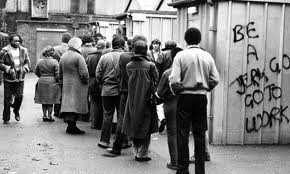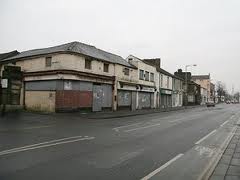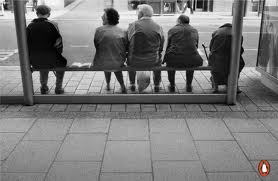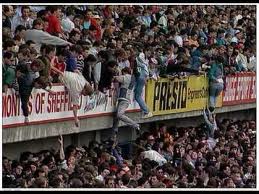Posts Tagged Hillsborough Stadium Disaster
Rise of Rave Part 2
Posted by Rupert Southcombe in Real, Sounds on January 3, 2011
“I was looking for a job and then I found a job and heaven knows I’m miserable now”
The Smiths ‘Heaven Knows I’m Miserable Now’. 1984.
Those of a sympathetic disposition to Thatcherite policies could argue that for the 87% of the workforce in employment, things were definitely looking up; more people were buying their own property and possessed more consumer goods than ever before.

Yuppie with essential 80s status symbol; a mobile phone the size of a house brick. Image: glossynews.com
The city workers known as the derogatory acronym, Yuppie – young urban professional person – flaunted their wealth by buying Porsches, Mercedes and getting personalised number plates. They would also spend their money on expensive designer clothes from exclusive boutiques.
The power suit was popular among men and also women, who for the first time were seriously challenging their male counterparts in climbing the corporate ladder. It wasn’t just the professional elite who could afford luxuries in the boom and bust consumerist environment; ordinary working class people could also afford colour TV’s, video recorders, stereos, computer games and dishwashers.
The Smiths on pop music institution Top of the Pops. 1984.
Advertisement for must-have 80s gadget the Walkman 1985.
The country’s media grabbed hold of the bust and boom economics and further espoused the ‘greed is good’ philosophy, they were after all owned by Lords and multi-national media and publishing empires who unsurprisingly were massively biased towards the government. Right wing papers such as The Sun which was then the best selling paper, concentrated on lowest common denominator tittle-tattle, and hounded celebrities and the Royal Family in search of salacious gossip and compromising pictures.
Television, which had seen the start of 24 hour programming with the start of breakfast T.V., was on the whole content to play it safe. Old and new favourites that continued to enforce stereotypes such as Coronation St and Eastenders were the most popular in British homes up and down the country.
80’s soap opera sex God – Benny of Crossroads.
MTV had only just started to be piped into British homes and lent itself perfectly to the superficiality of the 80s, showing all the mainstream artists in their latest videos in glamorous clothes and exotic locations. One such example shows Duran Duran singing their hit ‘Rio’ dressed in their finest suits on a yacht in the Caribbean. Perversely, considering the increasing Coca-colonization of Britain, its musicians such as U2, Queen and Def Leppard were the ones that dominated MTV playtime in the 80s. In 1985 Live Aid a massive concert in Wembley Stadium was staged in aid of famine relief for a slowly starving Ethiopia. Organised by the now Sir Bob Geldof, it was a definite reaction to the greed of the times the whole country came together and raised 14 million.
Sir Bob Geldof gets a bit sweary during Live Aid plea for more money.
The big films of the day were Gandhi, Chariots of Fire, A Passage to India and the film of George Orwell’s 1984. All these films give us a glimpse into the British psyche of the time as they all harked back to a day when Britain was still an Empire. With the increasing Americanisation at home most Britons were dreaming of Britannia still ruling the waves. The only exception to this is the film of George Orwell’s 1984. It warned of a frightening future of state control which became ever more prophetic to 80s Britain’s, with the increase in political lies, censorship, C.C.T.V. and MI5’s concentration on domestic targets.
Film version of George Orwell’s 1984.
In his book ‘Britain Since 1945’ David Childs talks about how shopping took on a new significance in the 80s, with the development of huge American style shopping malls which took the emphasis away from the town centre and high streets. It created a new ‘consumers paradise’ where identikit retail outlets started to peddle their wares in identikit malls up and down Britain. Big Macs, elevator muzak and faux designer clothing became the new retail norm. The end result was the erosion of centuries of traditional high street shopping. British town and village life suffered as a result with small businesses sacrificed at the new altar of consumerism. British businesses bounced back through diversification but for old and young, urban and suburban, there was increased marginalisation.
Religion which had been heavily declining for the last half century continued to do so; the values and beliefs held by the church belonged to a very different era and did not fit in with modern living. In the past going to church was an expression of belonging and of civic responsibility; however in the 80s many young people felt widespread alienation from many institutions of British society including church.
Alexei Sayle – A scouse take on God.
For young people in Thatcher’s Britain the future didn’t look too bright. Despite the materialism that was displayed all around them, education cuts had led to teachers’ strikes. Many young people left school with no job opportunities, with no option but to sign on to receive benefits. This left them on the streets with time on their hands, and during this time there was a proportionate increase in crimes resulting in overcrowding of prisons, sparking prison riots in 1989.
Pink Floyd get a dose of punk attitude and rail against indoctrination in education. 1980
Young people were limited in what they did for a night out. In towns up and down the country, young people looked for excitement and escapism; and finding none, got drunk on cheap alcohol in stuffy outdated pubs and fought with the youths from the next town. There was a large rise in football hooliganism during this time as disenfranchised youths looked for somewhere or something to belong to. Mostly male youths would become part of their local football ‘firm’ and go to a game for the football, but primarily for the violence between rival gangs that would ensue afterwards. They were highly organised and played a game of cat and mouse with the police and rival gangs. The football casuals as they came to be known – avoided club colours as not to get stopped by the police – and instead their uniform was expensive European designer clothing like Lacoste track suits, Fila or Pierre Cardin jumpers and Adidas shoes.
Young wannabe football casuals on yoof TV show The Network in 1983.
‘West Ham taking liberties at Millwall.’
Hooliganism was one of the big social issues of the time, questions were asked repeatedly in the House of Commons about what the government were going to do about the increasing yob culture. In 1985 an awful precedent was set with the Heysel Stadium disaster. Before the televised European Cup Final between Liverpool and Juventus, 39 people were killed as a result of awful policing, fighting between fans and an unsafe stadium. English teams and fans were banned from Europe indefinitely.
In 1989 football disaster struck again at the Hillsborough Stadium in Sheffield. Liverpool fans involved again, as 96 people horribly trapped in the stands were crushed to death. Hooliganism this time wrongly blamed, as it was the result of incompetent police control.






